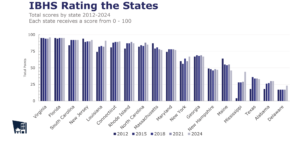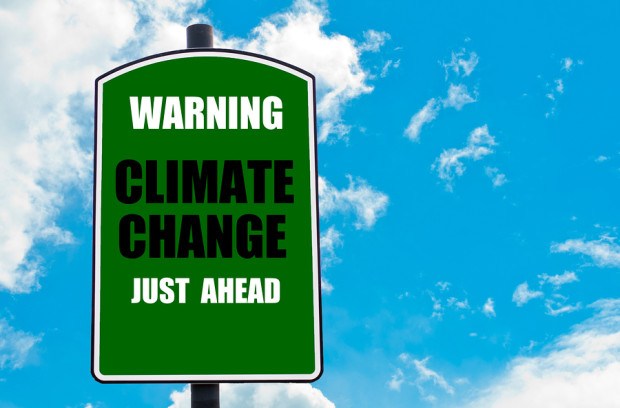A pair of highly anticipated government studies, one of them due to be released this week, could complicate President Donald Trump’s effort to roll back federal climate regulations, according to people on both sides of the debate over global warming.
A National Oceanic and Atmospheric Administration-backed report summarizing the global effects of climate change in 2016 is scheduled for release Thursday. Its conclusion will be similar to previous years’ versions, according to people familiar with the report: Climate change is real, it’s man-made and it’s dangerous.
That report dovetails with a broader National Climate Assessment, which is due next year from the administration. Drafts of the study, compiled by scientists from across the federal government, show the effects of climate change in the U.S. are severe.
Both reports are at odds with Trump’s contention that climate change is a “hoax” and may hinder his moves to undo President Barack Obama’s efforts to address the issue, analysts say. Revoking Obama’s rules requires agencies to give a legally sound justification for the policy pivots — such as arguing they are no longer necessary.
David Schnare, who worked on Trump’s transition team at the Environmental Protection Agency and then advised EPA Administrator Scott Pruitt, said that both reports will make it harder for the agency to reverse the Obama administration’s limits on carbon dioxide emissions from power plants, as well as the broader policy that defines those emissions as a danger to the public, called an endangerment finding.
“If the NCA comes out with an unflattering report on carbon dioxide, the only way EPA can change its endangerment finding is to reexamine all that science, and have a reasonable basis for rejecting” it, said Schnare, who left EPA in March. Once those reports become public, “it’s hard to dodge,” he said.
Opponents of Trump’s climate policies agreed that the reports could slow his administration’s repeal of Obama-era regulations.
“It will make it harder for them to justify,” said David Hawkins, director of climate programs for the Natural Resources Defense Council. “It’s yet another document that weighs against whatever claims Trump political appointees attempt to make about the state of the science.”
Thursday’s report, which was written by more than 450 scientists in the U.S. and abroad, will show that ice levels in Antarctica have set a record low, according to Keith Seitter, executive director of the American Meteorological Society. Antarctic ice levels had previously been increasing, a point highlighted by those who say climate change is a hoax.
The study will be released in the group’s Bulletin of the American Meteorological Society.
Otherwise, the report doesn’t contain many surprises, according to Seitter — because the public has become accustomed to continually breaking temperature records. On Tuesday, NOAA reported that 2017 is so far the second-warmest year to date.
Pope Francis Wrestles With Curia, Climate and Trump: QuickTake
“As a standard practice, NOAA does not discuss leaked or draft reports,” said Brady Phillips, a spokesman for the agency.
NOAA’s willingness to publicize data about the threat of climate change presents a stark contrast with other agencies. The EPA has removed information about climate change from its website; Pruitt has said human activity isn’t the primary contributor to global warming, as has Secretary of Energy Rick Perry. And the Interior Department reassigned dozens of employees, including one scientist who said his transfer to an office processing revenue was in retaliation “for speaking out publicly about the dangers that climate change poses to Alaska Native communities.”
An Interior spokeswoman declined to discuss specific personnel matters among the senior executive service and said the reassignments “are being conducted to better serve the taxpayer and the department’s operations.” The EPA didn’t respond to a request for comment.
The difference, according to Schnare, reflects the fact that the Trump administration has yet to assign political appointees to NOAA, which has left the agency — a division of the Department of Commerce — with an unusual degree of independence. Nor has the administration filled key climate positions at the White House; the Office of Science and Technology Policy still has no confirmed director, preventing it from aligning policy across federal agencies.
“This administration has simply not gotten its coordinating process together,” said Schnare.Ross Gillfillan, a spokesman for the science office, declined to comment.
National Assessment
A test of that coordinating process will be the National Climate Assessment, which the White House is required by Congress to release every four years. The last report, in 2014, concluded that average global temperatures had increased more than 1.5 degrees Fahrenheit (0.8 Celsius) since 1880, and predicted as much as four feet of sea-level rise by 2100. A draft version of the 2018 report projects temperatures in the U.S. will rise as much as 12 degrees if emissions aren’t reduced. The New York Times reported Tuesday that scientists involved were worried the Trump administration would suppress that study.
“The White House will withhold comment on any draft report before its scheduled release date,” White House spokeswoman Sarah Sanders said in a statement referring to the New York Times story.
Hawkins, of the Natural Resources Defense Council, said the administration could in theory try to stop publication of the final report, which must be approved by 13 federal agencies; it could even go so far as to reassign or fire the scientists working on it. But, he added, those strategies are unlikely to do much good.
“Now that the current draft report is public knowledge, firing people isn’t going to undermine the validity of what’s written down,” Hawkins said. “They can’t prevent the understanding of the science anymore than Canute could hold back the seas.”





















 Cat Losses, Auto and HO Price Hikes Continue at Allstate
Cat Losses, Auto and HO Price Hikes Continue at Allstate  Progressive Gains as Drivers Shop Around for Auto Insurance—Again
Progressive Gains as Drivers Shop Around for Auto Insurance—Again  Study: Average Cyber Breach Insurance Coverage Gap is 350%
Study: Average Cyber Breach Insurance Coverage Gap is 350%  InsurTech Profile: Optimalex’s AI Tools ‘Co-Pilot’ Alongside Human Expertise
InsurTech Profile: Optimalex’s AI Tools ‘Co-Pilot’ Alongside Human Expertise 







